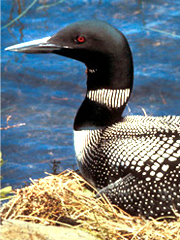|
COMMON LOON } Gavia immer

|
RANGE: In summer, breeds in Alaska, Canada, and northern United States; winters along coastlines and in lakes throughout North America
STATUS: The International Union for Conservation of Nature lists the common loon as a species of Least Concern.
THREATS: Lead poisoning from fishing sinkers, mercury poisoning, pollution, habitat loss due to human encroachment, and dam building
The common loon is an accomplished flier and swimmer, but a loon on land is anything but graceful. Its feet are placed almost as far back as its tail, which makes them excellent propellers when swimming underwater but nearly useless for walking. That’s why common loons stay air- or water-borne as much as possible, coming ashore only to mate and incubate their eggs. During the summer breeding season their tremulous, wailing calls echo eerily across the clear, secluded freshwater lakes they inhabit. As humans encroach on their territory, common loons are losing vital habitat to lakeside houses and marinas, and mercury poisoning and pollution from lead fishing sinkers pose dire threats to their health.
|